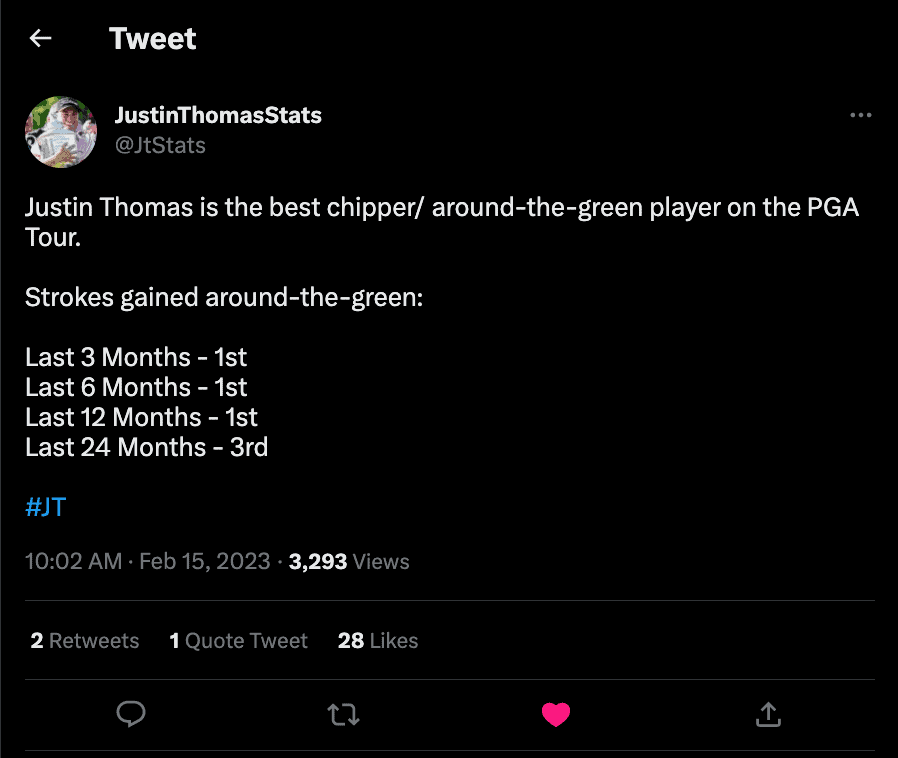- Updated: March 21, 2023
How to Chip in Golf
Legends of golf like Tiger Woods and Phil Mickelson are arguably most well-known for their prowess with a wedge in their hands. Both are experts at chipping the ball close what feels like every time they have the chance.
Getting good at chipping is one of the skills that separates most weekend-warrior high handicappers from someone you consider to have a “serious game.”
Because the chipping move is unique and different from most other swings, many “unknown” variables can lead to confusion and anxiety when tasked with a challenging shot until someone is taught how to chip correctly.

Today’s guide gives golfers an expert lesson on how to chip, including the basic technique as well as our favorite tips from the pros on how to master our short game.
What is Chipping?
Many golfers use the terms “Chipping” and “Pitching” interchangeably, but they are drastically different things.
If you haven’t read our breakdown of “Chipping vs. Pitching,” we’ll include a simple recap:
We remember “Chipping” as a short shot that’s Close to a green and usually rolls the majority of the way to (or in) the hole. It’s one of the least forceful swinging motions we make, which is why many say it requires “touch” and “feel.”

“Pitching” is for slightly more “Powerful “pitch shots” that are farther away from the hole and require a larger swinging motion but are still under 50-75 yards. They usually have to travel farther than they roll but can still roll quite a bit if needed.
The "Goal" of Chipping
The basic idea of a chip shot and chipping, in general, is to carry the rough, fairway, or fringe/collar of the green you’re close to and have the ball finish close to or inside the hole!
A few unique key concepts to chipping make it so different compared to every other type of swing with other clubs.
Understanding Chipping Setup
Creating Consistent Solid Contact Through Proper Technique
Building a Reliable Ability to Control Distance
Our guide will teach readers how to build a chipping motion that combines these three key concepts and will help players make more up and downs to shoot lower scores!
Proper Chipping Setup
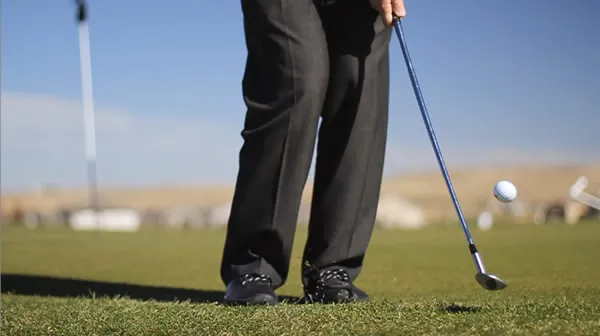
The player’s stance, ball position related to their stance, and how their weight is distributed between their legs are all unique parts of chipping that, when performed correctly, will lead to consistently getting up and down.
1. Keep your feet closer together than with every other shot, and aimed slightly open to your target line. This helps you rotate around your body and avoid excess rotation and swaying that can cause inconsistency.
2. Feel like you’re leaning 60-70% of your weight on your lead leg. Some golfers call this “posting up on their leading side,” but this move further emphasizes less sway and more pure rotation.
3. Position the ball in the center of your stance for most chip shots. (If you want more height, move the ball forward and closer to your front foot. If you want less height, move it backward.)
How to Develop Solid Contact Every Chip Shot
Golfers struggling with making solid contact with their chip shots often try to help the ball in the air with a “scooping motion,” which leads to hitting the ball thin over the green or chunking shots that go nowhere.
The clubs used to perform chips most often (sand wedges of all degrees, pitching wedges, and “scoring irons”) have more than enough loft to help the ball in the air on their own without us having to try (and failing) to scoop it.
Instead of “scooping” at the ball on your chips, try Phil Mickelson’s favorite chipping technique:
Phil Mickelson - Hinge and Hold Method of Chipping Technique
As you hopefully noticed, watching his quick 30-second instructional video, Phil Mickelson has spent an enormous amount of time diagnosing how to chip and the proper technique to develop consistent chipping contact.
Below, we break down his famous “Hinge and Hold Method” for our readers’ convenience.
Every great short-game artist in the game’s history has emulated this technique in one form or another!
Phil Mickelson's Chipping Method Step-by-Step:
Following our “Proper Chipping Setup” guidelines above, practice the feeling of “Hinging” (or breaking) your wrists on the backswing and being able to hold this angle once you’ve created it.
Once you’ve found the top of your short chipping backswing, keep “Holding” the angle you’ve created with your wrist hinge as you accelerate toward the golf ball.
*BONUS Phil Mickelson Chipping Tip!* After practicing his method a few times, work on beginning the routine with a small amount of “forward shaft lean” (bring the handle of the club closer to the target line).
Following Phil’s “Hinge and Hold Method” and bonus tip, golfers will naturally present the golf club to the ball at the proper angle to gracefully pop the ball in the air with consistent contact.
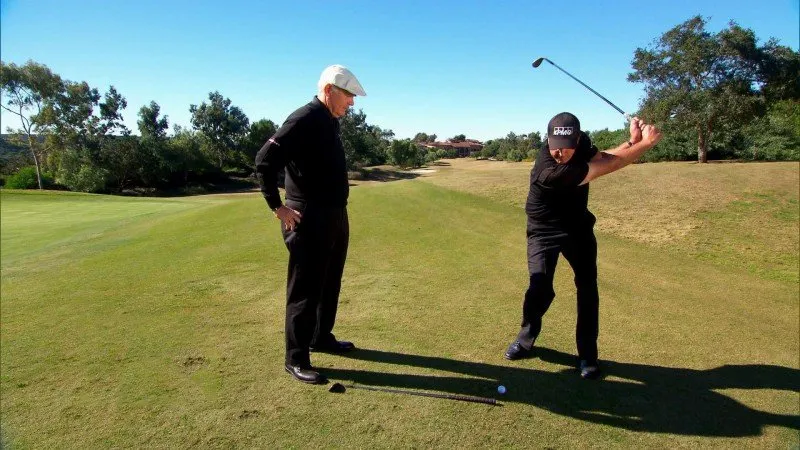
Reliable Ability to Control Distance
Distance control is the final step to master when it comes to learning chipping technique, but it’s by far the most fun to learn.
The primary reason reliably controlling distance with chip shots is so tricky is because each golf course will have different grass and green speeds, and the fact chip shots usually require a very short swing.
Regardless of those things, now that you have the proper chipping motion and setup down, controlling your distance now takes repetitions and experience playing different clubs and golf courses!
Here’s the simplest way to control distance with your chip shots:
Shorter chips will require a shorter swing with less body turn.
Longer chip shots will require a longer swing with slightly more body turn.
*BONUS Distance Control Tip*
When golfers hit chip shots, the upper body handles most of the work, and golfers can use this to their advantage.
Many players love to imagine their knees as the stopping point of their backswing and follow-through for short chips, their waist as the stopping point for medium-range chips, and their shoulders as their stopping point for longer chips.
How to Practice Distance Control (High School Chip Drill)
This drill was our ticket to be able to leave high school golf practice growing up and added a bit of pressure to the end of our days!
Grab 6 golf balls and head to your practice green or backyard.
Pick a specific (golf hole-sized) target 15 feet away, place a tee halfway between you and the target, then another tee the same distance past the primary target, effectively creating three targets in a straight line that are equal distances apart.
Hit your first two balls at the target the farthest away from you.
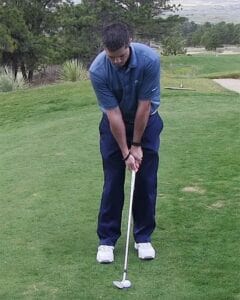
Walk to the target and measure your distance from the hole using your chipping clubs’ shaft. If your ball is closer to the target than the length of your club, go back to your starting position and repeat the process hitting 2 balls at the middle target!
Continue this routine until you’ve completed every shot and kept them inside this close range. If you make a mistake, pick up all your balls and start from ball one!
We love this drill because it helps golfers learn how to gain more control over long, medium, and short-distance chip shots and how to chip under pressure knowing each target must be completed in order and consecutively.
These are just some of the steps to becoming a great chipper!
What Clubs Are the Best to Chip With?
Since the primary objective is to get the ball in the air quickly with chip shots, using a club with more loft is very important.
We usually find the most success by chipping around the greens with our sand wedge(‘s) (52°, 56°, 60°), pitching wedge, and 7-8-9 irons.
You could chip with a hybrid if you want to, there are no specific and rigid rules to the clubs you use, but we’ve found most golfers chip using their wedges because they offer the most control (due to their grooves that add spin) and high loft angles.
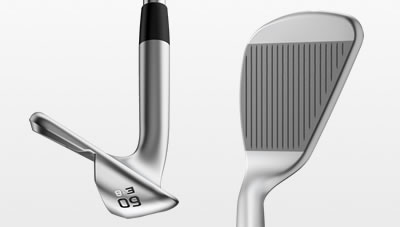
If you’re interested, we’ve created a few guides for the “Best Golf Chippers” and the “Best Sand Wedges” money can buy!
How to Make Chips Stop Quickly?
There are two primary ways to make a chip shot stop dead in its tracks, creating more spin or adding height.
Clean grooves and crisp contact are the only things that can manufacture additional spin on chip shots.
Additional height can be created by placing the ball farther forward in the golfer’s stance and opening the face of the club to present more loft than its standard degree.

Who is the "Best Chipper" / Has the Best Short Game on the PGA Tour?
The “best chipper,” or the golfer with the best short game on the PGA Tour for the last handful of years, is, without a doubt, Justin Thomas.
Other players have fantastic short games, don’t get us wrong, but statistically speaking, no one chips it better than J.T.
The PGA Tour evaluates a golfer’s performance using “Strokes-Gained Statistics.” In a nutshell, “Strokes-Gained” measures a golfer’s performance in specific aspects against the field of competitors to show where they are “gaining strokes” on their competition.
“Strokes Gained Around-the-Green” measures a golfer’s performance on any shot inside 30 yards (excluding putts) and compares it against every competitor.
Justin Thomas has ranked 1st in “Strokes Gained Around-the-Green” for the last 3, 6, and 12 months consecutively, demonstrating not only his mastery of the chip shot but his consistency at getting the ball close to the hole.
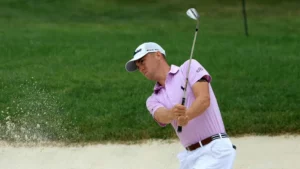
About The Author
Writers of Independent Golf Reviews
Independent Golf Reviews has tested and reviewed 1000+ golf products over the past 10 years. We use our experience and expertise to give golfers an unbiased insight on the market.
Read more…

